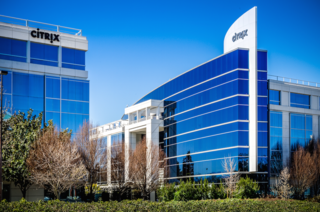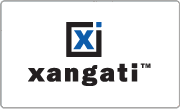Related Research Articles

A thin client is a lightweight computer that has been optimized for establishing a remote connection with a server-based computing environment. The server does most of the work, which can include launching software programs, performing calculations, and storing data. This contrasts with a fat client or a conventional personal computer; the former is also intended for working in a client–server model but has significant local processing power, while the latter aims to perform its function mostly locally.

Citrix Systems, Inc. is an American multinational software company that provides server, application and desktop virtualization, networking, software as a service (SaaS), and cloud computing technologies. Citrix products are claimed to be in use by over 400,000 clients worldwide, including 99% of the Fortune 100, and 98% of the Fortune 500.
Desktop virtualization is a software technology that separates the desktop environment and associated application software from the physical client device that is used to access it.
In computing, the term remote desktop refers to a software or operating system feature that allows a personal computer's desktop environment to be run remotely on one system, while being displayed on a separate client device. Remote desktop applications have varying features. Some allow attaching to an existing user's session and "remote controlling", either displaying the remote control session or blanking the screen. Taking over a desktop remotely is a form of remote administration.
This page is a comparison of remote desktop software available for various platforms.
Ericom Software, Inc. is a Closter, New Jersey-based company that provides secure web isolation and remote application access software and cloud services to enterprises and medium-size businesses.
Remote Desktop Services (RDS), known as Terminal Services in Windows Server 2008 and earlier, is one of the components of Microsoft Windows that allow a user to take control of a remote computer or virtual machine over a network connection. RDS is Microsoft's implementation of thin client architecture, where Windows software, and the entire desktop of the computer running RDS, are made accessible to any remote client machine that supports Remote Desktop Protocol (RDP). User interfaces are displayed from the server onto the client system and input from the client system is transmitted to the server - where software execution takes place. This is in contrast to application streaming systems, like Microsoft App-V, in which computer programs are streamed to the client on-demand and executed on the client machine.
Pano Logic was a manufacturer of devices which present virtual desktops to the end user with no local processing power. They describe this concept as "zero client". This is perceived as offering benefits in end-user support and in power provision to desks. OEM versions have been included in displays from some vendors, allowing a single unit to be deployed. The company failed in October 2012. In March 2013, Propalms announced they had acquired the rights to support Panologic customers, and will "help transition the customer base to a new platform".
User environment management is the management of a computer user's experience within their desktop environment.

IGEL Technology is an international software company best known for their "Next generation edge operating system" which is purpose-built for secure access to cloud workspaces such as Virtual Desktop Infrastructure (VDI) and/or Desktop as a Service.
VMware Horizon is a commercial desktop and app virtualization product developed by VMware, Inc for Microsoft Windows, Linux and macOS Operating Systems. It was first sold under the name VMware VDM, but with the release of version 3.0.0 in 2008 it was changed to "VMware View". The name was updated to "Horizon View" with the launch of version 6 in April 2014 and is now referred to as "VMware Horizon" to represent desktop and app virtualization.
A hosted desktop is a product set within the larger cloud-computing sphere generally delivered using a combination of technologies including hardware virtualization and some form of remote connection software, Citrix XenApp or Microsoft Remote Desktop Services being two of the most common. Processing takes place within the provider's datacentre environment with traffic between the datacentre and the client being primarily : display updates, mouse movements and keyboard activity.
Leostream, founded in 2002, is a privately held technology company based in Waltham, Massachusetts. Its flagship product is a connection broker for virtual desktop infrastructure (VDI) and resources hosted in the datacenter.
Wanova, Inc, headquartered in San Jose, California, provides software to help IT organizations manage, support and protect data on desktop and laptop computers. Wanova's primary product, Wanova Mirage, was designed as an alternative to server-hosted desktop virtualization technologies, combining the centralization and management capabilities of virtual desktop infrastructure (VDI) with features that allow the system to work for laptops and other WAN-connected desktops. Mirage enables IT organizations to store the complete contents of each personal computer (PC) in the data center for centralized management and data protection. End users execute a locally cached copy of their centrally-stored PC, which makes it possible for users to use their PC whether or not they are connected to the network. The software includes additional features that optimize the system to work over a wide area network(WAN). Wanova Mirage software was designed for information technology organizations supporting distributed enterprises and has three primary components: the Mirage Client, Mirage Server and capabilities that optimize network and storage efficiency.
Login Virtual Session Indexer is an IT company that specializes in software technology to test and monitor the performance and availability of centralized desktop environments, such as server-based computing, virtual desktop infrastructure (VDI) and desktop as a service (DaaS). The technology is used by large organizations using Citrix XenApp, Citrix XenDesktop, VMware Horizon and Microsoft RDS.

Teradici is a privately held software company founded in 2004, with its head office in Metropolitan Vancouver, BC. Teradici initially developed a protocol (PCoIP) for compressing and decompressing images and sound when remotely accessing blade servers, and implemented it in hardware. This technology was later expanded to thin clients/zero clients for general Virtual Desktop Infrastructure. Teradici's protocol or hardware is used by HP, Dell-Wyse, Amulet Hotkey, Samsung, Amazon Web Services, Fujitsu, and VMware.

2X Software was a Maltese software company specializing in virtual desktop, application virtualization, application delivery, Remote Desktop Services, remote access and Mobile Device Management. On 25 February 2015, 2X Software was acquired by Parallels, Inc. The 2X products, Remote Application Server and Mobile Device Management, are now included in Parallels' offering.

Xangati, Inc is an American-based private company, that provides service assurance analytics software for enterprises and service providers, operating in virtualized data centers and hybrid cloud environments.
Remote mobile virtualization, like its counterpart desktop virtualization, is a technology that separates operating systems and applications from the client devices that access them. However, while desktop virtualization allows users to remotely access Windows desktops and applications, remote mobile virtualization offers remote access to mobile operating systems such as Android.
Citrix Virtual Apps is application virtualization software produced by Citrix Systems that allows Windows applications to be accessed via individual devices from a shared server or cloud system.
References
- ↑ "Ericom Connect v7: A rewrite of its VDI product that seems more modern than Citrix or VMware!". BrianMadden.com. Retrieved 2019-02-21.
- 1 2 "Got some downtime in the next week? Check out Ericom Connect 7.3". BrianMadden.com. Retrieved 2019-02-21.
- ↑ "How long can Ericom's HTML 5 client dominance last?". SearchVirtualDesktop. Retrieved 2019-02-21.
- ↑ "Do Google Chromebooks have a place in the enterprise?". SearchVirtualDesktop. Retrieved 2019-02-21.
- ↑ "Ericom's first Kenyan partnership conference concludes |IT News Africa – Up to date technology news, IT news, Digital news, Telecom news, Mobile news, Gadgets news, Analysis and Reports | Africa's Technology News Leader". www.itnewsafrica.com. Retrieved 2019-02-21.
- ↑ "Ericom Connect - RSA SecurID Access Standard Ag... | RSA Link". community.rsa.com. Retrieved 2019-02-21.
- ↑ "Ericom Connect v7: a ground-up rewrite of their desktop virtualization product that seems more modern than Citrix or VMware!". Loughtec. 2015-04-15. Retrieved 2019-02-21.
- 1 2 "Ericom Connect brings a modern backend to VDI". SearchVirtualDesktop. Retrieved 2019-02-21.
- ↑ "Ericom Connect Multiplies by Ten-fold the Management Capacity of Citrix and VMware". www.msptoday.com. Retrieved 2019-02-21.